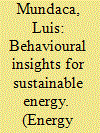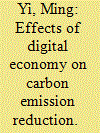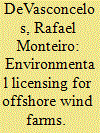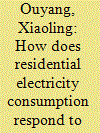|
|
|
Sort Order |
|
|
|
Items / Page
|
|
|
|
|
|
|
| Srl | Item |
| 1 |
ID:
187609


|
|
|
|
|
| Summary/Abstract |
We present a case study and analysis of Alberta's Renewable Electricity Program, one of a suite of policies implemented between 2015 and 2019 to increase the share of renewable generation in the Canadian province's fossil-fuel-dominated electricity system. The program consisted of a series of reverse auctions for contracts-for-differences which provided successful proponents with a project-specific guaranteed price for power generation. We find that the Renewable Electricity Program was successful in three important ways. First, it contracted for new renewable generation at prices in the range of CA$30 to CA$43/MWh (US$23 to US$33/MWh), well below expectations and among the lowest procurement costs globally at the time. These contracts have resulted in gains to the government of CA$75.5 million (US$60 million) to date. Second, the program ushered new entrants into Alberta's power market, including through mandated Indigenous equity participation in one round of auctions. Third, we find that price discovery and the incentive to develop new projects provided by the program spurred privately-financed development. While the program was a success, we argue that its design did not adequately reward high-value generation, which could have become an issue in future auction rounds. We analyse design alternatives that would have improved the program's dynamic efficiency.
|
|
|
|
|
|
|
|
|
|
|
|
|
|
|
|
| 2 |
ID:
187587


|
|
|
|
|
| Summary/Abstract |
Electric roadways (ERs) represent a new paradigm for electrified transportation that is enabled by the emerging technology of dynamic (in-motion) wireless power transfer to electric vehicles (EVs). This kind of ubiquitous charging capability alleviates range anxiety, and can thus stimulate the adoption of EVs. However, large-scale deployment of ERs is challenging due to its high capital cost and resource-intensive nature. This paper presents a detailed analytical framework for the techno-economic assessment of planned ER projects. The methodology is illustrated using an early adoption case study on Interstate 65 in Indiana, USA. Multiple financial feasibility and risk analyses of various ER designs and implementation scenarios are conducted. The overall financial viability of the ER project is evaluated using the levelized cost of the electric roadway and its net present value. The results indicate that the EV penetration level, and especially that of heavier-duty long-haul EVs, has the greatest impact on financial viability, which suggests the critical role of sustained policies that would help accelerate adoption of this technology. The results are also supportive of developing “green” ERs, wherever synergies between renewable energy sources and traffic corridors can be exploited to co-develop solar and wind power plants with ERs.
|
|
|
|
|
|
|
|
|
|
|
|
|
|
|
|
| 3 |
ID:
187584


|
|
|
|
|
| Summary/Abstract |
Behavioural insights are increasingly shaping the design, implementation and evaluation of energy policies. This Special Issue aims to broaden and strengthen the evidence base, and policy value of behavioural insights in the context of sustainable energy use. It showcases a plethora of behavioural issues that can help to improve our understanding of the decision-making ‘black box’ of energy users and the contexts in which behaviours take place. Our editorial focuses on five cross-cutting themes, namely: interdisciplinarity, policy experimentation, non-economic factors, the diffusion of low-carbon innovations, and digitalisation. Findings across these themes reveal various challenges (e.g. timescales of energy behaviours, scaling of policy experiments, heterogeneous treatment effects) and four overarching areas are identified when policy implications are examined horizontally: ambition, integration, cooperation and ethics. We conclude that the application of behavioural insights to sustainable energy use provides a rich body of evidence and approaches to support our understanding of complex policy issues. It is an interdisciplinary and resource-intensive process that can effectively assist policymaking by encouraging behaviour change via more integrated, (cost-) effective interventions. Knowledge exchange between social scientists and policymakers is crucial for behavioural insights to realise their full potential. Ethical considerations call for good research practices and improved governance.
|
|
|
|
|
|
|
|
|
|
|
|
|
|
|
|
| 4 |
ID:
187585


|
|
|
|
|
| Summary/Abstract |
Coal remains an irreplaceable main energy source in China. This paper uses the zero-sum gain data envelopment analysis (ZSG-DEA) model, and proposes a production capacity optimization allocation plan, which provides a theoretical basis for how to ensure energy security in the context of China's dual-carbon strategy. Results show: (1) the optimal plan adjusts the production capacity by 7.32 million tons/year, accounting for 6.33% of the total production capacity; 32 mines will be increased in production capacity, and 19 mines will be reduced in production capacity. (2) Under the optimal plan, the raw coal output, income, and profit of provincial coal mines will increase by 3.5965 million tons, 2.65 billion yuan, and 0.972 billion yuan, respectively, and wages are expected to decrease by 73.5 million yuan. (3) In terms of the fairness of personnel placement, the Gini coefficient of the actual situation is 0.3082, and that of the optimal scheme is 0.2896. It suggests that engaging in the “one size fits all” campaign of marginalization and coal decoalization is unadvisable. Coal supply and market demand should be efficiently connected, and the elimination of backward production capacity and the release of advantageous production capacity should be rationally coordinated.
|
|
|
|
|
|
|
|
|
|
|
|
|
|
|
|
| 5 |
ID:
187599


|
|
|
|
|
| Summary/Abstract |
Energy transitions require engagement with users, local communities and wider publics in order to be fair, acceptable and, ultimately, successful. Here we focus on the development of decentralised energy systems instigated by central government. Smart Local Energy Systems (SLES), involving low carbon generation, demand sources and smart technologies in a geographically-bounded location, are important but unexplored contexts for public engagement. Drawing on 23 interviews with partner organisations in 12 UK SLES projects, we investigate the targets, methods and rationales of engagement. Partners engage a range of user and community groups around multiple energy system components using a variety of methods, directly and via intermediary organisations. Project size is not a major influence on breadth and intensity of engagement. Project partners rationalise practices with reference to characterisations of users and engagement, and practices are conditioned by a range of factors (e.g. technological boundaries, place, partners involved, and the wider organisational context within which SLES projects take place). We highlight a need for future SLES policy to emphasise engagement as a key facet, institute systematic social learning between SLES projects, and consider how to engage publics beyond the boundaries of individual projects.
|
|
|
|
|
|
|
|
|
|
|
|
|
|
|
|
| 6 |
ID:
187593


|
|
|
|
|
| Summary/Abstract |
Green certificate trading systems have been developed to improve renewable energy support policies and innovative development mechanisms. To more intuitively analyze the decision-making behavior of power suppliers under green certificate schemes, we constructed a system dynamics-based model and carried out a case study using the scenario analysis method. The model clearly shows the complex logical relationship among the factors involved and reveals the decision-making process of the power producers of green certificates. This paper is also relevant for scholars from various countries seeking to understand the trading strategies of green certificate mechanisms and provides a reference for concerned decision-making bodies. The results indicate that under different scenarios and considering the restrictions and effects of the renewable portfolio standard (RPS) quota ratio, the transaction cost ratio and penalty mechanisms, compared with green power enterprises, thermal power enterprises are willing to enter the green certificate market for trading as the government's support for RPS increases. Finally, relevant policy suggestions are put forward to promote the development of renewable energy in China.
|
|
|
|
|
|
|
|
|
|
|
|
|
|
|
|
| 7 |
ID:
187588


|
|
|
|
|
| Summary/Abstract |
A novel planning tool is introduced for projecting vehicle and fueling infrastructure deployment of near-zero and zero emission heavy-duty vehicles (HDVs). To address climate change and air quality goals, the tool is based on a systematic methodology to develop rollout scenarios that meet environmental goals at the lowest cost, and identify policy to facilitate the deployment. Called TRACE (Transportation Rollout Affecting Cost and Emissions), the methodology provides a framework for developing and analyzing scenarios that consider the technical and socio-political constraints and incentives in the emerging HDV sector. For the California Greenhouse Gas (GHG) Scenario requiring an 80% reduction in 1990 GHG levels by 2050, TRACE projects a significant population of biomass-sourced renewable diesel-fueled internal combustion vehicles, complemented by a substantial population of battery and fuel cell electric powertrain adoption by 2050. In contrast, the Zero Emission Vehicle Scenario projects a near-complete (100%) adoption of battery and fuel cell electric powertrains by 2050 with a 0.53% higher cumulative cost than the GHG Scenario. The policy implications include a need for (1) near-term benefits of low/negative carbon intensity biomass without diminishing adoption of zero emission HDVs, and (2) both renewable fuel and fuel cell electric vehicle incentives tailored to vocational demand.
|
|
|
|
|
|
|
|
|
|
|
|
|
|
|
|
| 8 |
ID:
187583


|
|
|
|
|
| Summary/Abstract |
A novel planning tool is introduced for projecting vehicle and fueling infrastructure deployment of near-zero and zero emission heavy-duty vehicles (HDVs). To address climate change and air quality goals, the tool is based on a systematic methodology to develop rollout scenarios that meet environmental goals at the lowest cost, and identify policy to facilitate the deployment. Called TRACE (Transportation Rollout Affecting Cost and Emissions), the methodology provides a framework for developing and analyzing scenarios that consider the technical and socio-political constraints and incentives in the emerging HDV sector. For the California Greenhouse Gas (GHG) Scenario requiring an 80% reduction in 1990 GHG levels by 2050, TRACE projects a significant population of biomass-sourced renewable diesel-fueled internal combustion vehicles, complemented by a substantial population of battery and fuel cell electric powertrain adoption by 2050. In contrast, the Zero Emission Vehicle Scenario projects a near-complete (100%) adoption of battery and fuel cell electric powertrains by 2050 with a 0.53% higher cumulative cost than the GHG Scenario. The policy implications include a need for (1) near-term benefits of low/negative carbon intensity biomass without diminishing adoption of zero emission HDVs, and (2) both renewable fuel and fuel cell electric vehicle incentives tailored to vocational demand.
|
|
|
|
|
|
|
|
|
|
|
|
|
|
|
|
| 9 |
ID:
187606


|
|
|
|
|
| Summary/Abstract |
Recently, the progress of reaching carbon emission peaks and achieving carbon neutrality has had significant impacts on the global economy. The overall societal efforts on carbon emission reduction from various industries will likely be strengthened, thanks to the advantages enterprises could gain in digital technologies through a structural upgrade in the energy systems. Based on China's provincial panel data from 2011 to 2019, this paper constructs a spatial panel Durbin model and a mediating effect model to investigate the mechanism and influence of the digital economy on carbon emission reduction. The results show that (1) the development of the digital economy has a significant spatial spillover effect on carbon emission reduction; (2) the digital economy influences carbon emission reduction both directly and indirectly. This means that the carbon emission reduction can be affected indirectly by the digital economy through the transformation of energy structure; (3) the carbon emission reduction effect of the digital economy exhibits regional heterogeneity, it is more prominent in eastern regions than in other areas. The above findings provide substantial empirical evidence to policymakers on how to best promote the development of the digital economy and intensify the coordination of China’s digital infrastructure in regional environmental governance.
|
|
|
|
|
|
|
|
|
|
|
|
|
|
|
|
| 10 |
ID:
187586


|
|
|
|
|
| Summary/Abstract |
We assess the changes in Mexico's privately owned vehicle fleet and tax losses (fuel duty on gasoline) associated to the deployment of electric vehicles (EVs) through a diffusion model. Our projections for 2050 focus on a) electricity use of EVs, b) gasoline use and c) revenue for Mexico's treasury. The model uses population growth and vehicles sales to project two items: a) EV diffusion and b) substitution rates of ICVs with EVs. The equation uses vehicle km travelled and average consumption of fuel to calculate gasoline use of vehicles.
|
|
|
|
|
|
|
|
|
|
|
|
|
|
|
|
| 11 |
ID:
187604


|
|
|
|
|
| Summary/Abstract |
Peru currently presents serious challenges in the promotion and production of renewable energies, making it difficult to fulfill its commitments to reduce greenhouse gas emissions within the framework of the United Nations Climate Change initiatives. Peru has a high renewable energy potential with various sources: solar, wind, geothermal, biomass and hydroelectric. However, after twelve years of having promulgated a law to promote the development of power plants that use renewable energy resources through auctions, only about 5% of current electricity generation comes from renewable sources and the auctions are suspended.
|
|
|
|
|
|
|
|
|
|
|
|
|
|
|
|
| 12 |
ID:
187598


|
|
|
|
|
| Summary/Abstract |
This paper aims to analyze the implications of the energy transition policies in Argentina and Brazil. The paper's goal is to illustrate that the two countries are undergoing a transformation of their energy systems toward greater diversification of the energy supply and probably, not a socially inclusive one. Based on data on national energy policies, the evolution of the energy supply mixes over the period 1990–2020, and access to electricity by the households at the national level, the paper offers a critical reading of how the two countries faced the challenges posed by the present process of energy system transformation. The paper adopts a political economy and political ecology perspective employing the notion of just energy transition (JET) to illustrate the contradictions and tensions of the latter approach analyzing quantitative data related to the transformation of the energy system and energy poverty in both Argentina and Brazil.
|
|
|
|
|
|
|
|
|
|
|
|
|
|
|
|
| 13 |
ID:
187596


|
|
|
|
|
| Summary/Abstract |
Decarbonising residential heating poses a major challenge for the energy transition, but the policy attention devoted to and the support provided for it seem limited. There is a rather limited consideration of the perceptions of households, which play a large role in this sector. This in turn may affect the effectiveness of policy instruments. This study contributes to a better understanding of the various perceptions held by key stakeholders, in particular about what can be done to reduce residential heating bills and how. We use a participatory method based on Fuzzy Cognitive Mapping (FCM), which accounts for the behavioural complexity of the transition in residential heating and provides a better understanding of policy instruments in terms of stakeholder perception. We then test combinations of policy instruments based on expert opinion and identify the most effective ones based on their perceptions. Our analysis indicates that environmental education and information are perceived to reduce heating bills by a very significant amount. Taxes are perceived to be more effective than subsidies. We also show that policy packages are considered essential: when policy instruments are combined the effects perceived are cumulative, resulting in a much greater expected impact on heating bills and energy consumption.
|
|
|
|
|
|
|
|
|
|
|
|
|
|
|
|
| 14 |
ID:
187602


|
|
|
|
|
| Summary/Abstract |
Offshore wind energy is a key driver of the global energy transition towards climate change. The regulatory framework in environmental licensing for renewable energy sources is specific for each country, however there are basic elements that can be replicated for new markets. This article aims to propose guidelines and policy implications in environmental licensing for offshore wind projects for new markets based on the state of the art and lessons learned from three mature countries and one emerging market. The research involved three phases: literature review on sustainable development and environmental licensing procedures for offshore wind farms; research cases in the United Kingdom, Germany, Denmark, and Taiwan; and the structuring of guidelines and policy implications. As a result, eight guidelines and their policy implications are proposed, among them: (i) Establishment of a national offshore wind energy production target; (ii) Mapping of marine offshore wind zones; (iii) Adoption of a “one-stop-shop” procedure; (iv) Development of a guide for environmental licensing for offshore wind farms; and others. In conclusion, the establishment of a regulatory framework in environmental licensing for offshore wind projects, based on sustainable development principles and good practices of leading markets, guides public policies of new markets to have a greater probability of sustainable development.
|
|
|
|
|
|
|
|
|
|
|
|
|
|
|
|
| 15 |
ID:
187616


|
|
|
|
|
| Summary/Abstract |
Europe has recently confirmed and augmented its commitment towards full decarbonization through the EU Green Deal and the Fit for 55 package. Energy policy struggles to keep up with technical and business novelties, often constituting an obstacle for technological innovation. Regulatory sandboxes and pilot projects have recently played a central role in the policy strategy adopted by many countries, but a common framework is still missing. In this work, moving from the approaches adopted by Ofgem in Great Britain and Arera in Italy, a list of experimental dimensions is firstly proposed, and the most important trialling experiences individuated worldwide are mapped on it. Therefore, clustering these experiences based on their characteristics, a reference taxonomy to design and classify regulatory experiments is proposed. In parallel, topics addressed within trials are described and mapped on the main challenges posed by EU Green Deal targets on the power system. The analysis highlights that there is no one-size-fits-all approach towards regulatory experimentation, and that effort is needed to ensure coordinated initiatives within and among European countries, in order to timely achieve a net-zero energy system in the most effective way.
|
|
|
|
|
|
|
|
|
|
|
|
|
|
|
|
| 16 |
ID:
187601


|
|
|
|
|
| Summary/Abstract |
Energy conservation from efficiency-oriented policies could be undermined due to the substitution effect and the income effect originating from the fact that energy efficiency improvement decreases the real price of electricity consumption. The ratio of the electricity consumption caused by the substitution effect and the income effect to the potential energy savings is termed the rebound effect. The magnitude of the rebound effect depicts how residential electricity consumption responds to electricity efficiency improvement. This paper adopts a stochastic electricity demand frontier approach based on the panel data covering 278 cities in China to uncover the relationship between electricity efficiency and residential electricity consumption. The main results show that 48.88% of the energy saving from efficiency improvement is offset due to households’ behavior adjustments. We also find that residential income, population density, and temperature deviation are vital determinants of residential electricity consumption, whereas household size significantly shapes the magnitude of the rebound effect. The empirical findings imply that different regions in China should design supporting policies for energy efficiency improvement according to local conditions considering that households are incentivized to consume more electricity with efficiency improvement.
|
|
|
|
|
|
|
|
|
|
|
|
|
|
|
|
| 17 |
ID:
187615


|
|
|
|
|
| Summary/Abstract |
Climate negotiations on low-carbon technology transfer have largely revolved around the role of intellectual property rights (IPR). Some countries consider a strong IPR regime to be a necessary condition for technology transfer, while others argue that it limits developing countries' access to affordable green technologies. We contribute to this discussion by assessing the effect of IPR protection on the two main channels of international low-carbon technology transfer, namely trade in low-carbon capital goods and foreign direct investment (FDI) by firms owning low-carbon technologies. Our data describe transfer through these channels among 140 countries in eight climate-friendly technology areas between 2006 and 2015. We find that stronger IPR protection in recipient countries increased transfer in six technology areas (solar PV, solar thermal, wind, heating, lighting, and cleaner vehicles), while the effect is statistically insignificant in the other two (hydro and insulation). The results differ slightly when focusing on the case of non-OECD countries. Stricter IPRs did not have a statistically significant impact on trade in low-carbon capital goods, but they accelerated FDI in almost all low-carbon technology areas.
|
|
|
|
|
|
|
|
|
|
|
|
|
|
|
|
| 18 |
ID:
187610


|
|
|
|
|
| Summary/Abstract |
This paper investigates the trade-offs between progressivity and effectiveness for a carbon tax versus an ‘excessive consumption’ levy. To do this, we compare the distribution of consumer welfare impacts and environmental effectiveness of an air travel carbon tax and a frequent flyer levy. Results show that both policies have the potential to achieve substantial carbon mitigation with minimal impacts on consumer welfare. Nevertheless, compared with a carbon tax, a frequent flyer levy is more progressive and effective at reducing emissions – thus, there is no trade-off between progressivity and effectiveness by using an excessive consumption levy to mitigate air travel emissions. Furthermore, considering the pronounced growth in demand projected for air travel over the next 30 years, results show the frequent flyer levy will remain more progressive and effective over time. Although further research is needed to assess the trade-offs on the supply-side (e.g., protection of regular customers, dynamic efficiency) and related to implementation (e.g., data privacy, the role for revenue recycling), such an excessive consumption levy has the potential to be an equitable, effective and politically acceptable environmental policy for curbing carbon dioxide emissions. This is relevant not only for air travel but for other forms of consumption in which the affluent are responsible for a large share of demand and associated carbon emissions.
|
|
|
|
|
|
|
|
|
|
|
|
|
|
|
|
| 19 |
ID:
187613


|
|
|
|
|
| Summary/Abstract |
The European legislative framework asks for massive application of renewable energy source (particularly of photovoltaic systems) in the built environment to face the recent energy crisis, reducing energy demand, environmental emissions, and costs. These policies could generate serious preservations problems for architecturally sensitive areas, such as historical towns, historic buildings, and protected landscapes. Inside them, photovoltaic technologies have several benefits for the built environment related to aesthetic appeal, reliability, modularity, scalability, versatility, low maintenance costs, and peak shaving. The major challenge for their application is the presumed negative impact on heritage value. Thus, the diffusion of these systems in the territory is hindered by a social diffidence on their acceptability due to legislative, cultural, technical, and economic barriers. To support the definition of appropriate policies, and realistic targets, the study presents a complete discussion on policy-related design criteria for integrating photovoltaic systems on cultural heritage. This socio-technical analysis can increase a cleaner and integrated energy production, favoring the energy transition and the mitigation of climate changes, respecting heritage and natural values, and considering current energy needs, and innovative developments of photovoltaic systems. The comparison of relevant research projects, scientific studies, awards, and guidelines describes the state of the art of this topic, also identifying 42 international guidelines on energy efficiency, renewable sources, and solar integration on cultural heritage. International recommendations are categorized to find recurring, and applied design criteria for architectural heritage sites, protected landscapes, historic and traditional buildings, and building extensions. Then, updated criteria, pros, and cons for a possible integration are defined through specific focus groups with the Heritage Authorities. These activities are based on international criteria of architectural conservation. The synopsis of these results shows non-negotiable criteria for heritage-compatible solar applications. Finally, the study presents some policy-relevant implications connected with these design criteria, to define realistic energy targets and scenarios, to prepare strategic policy options (e.g., guidelines, rules, policies, and financial incentives) based on updated criteria, correct targets, and recent innovations, to implement existing energy policies in a correct way, to correctly assess restoration design projects, and to evaluate socio-economic trends of innovative photovoltaics' markets.
|
|
|
|
|
|
|
|
|
|
|
|
|
|
|
|
| 20 |
ID:
187605


|
|
|
|
|
| Summary/Abstract |
With the sustained expansion of energy demand, the energy crisis gradually become the core concern of society. Improving energy efficiency (EE) is crucial for saving energy and reducing emissions while ensuring economic growth. Environmental regulation is an effective tool to improve EE and environmental quality. This study introduces market supervision to further explore the impact of environmental regulation on EE. Taking environmental pollution liability insurance (EPLI) implemented in China as a quasi-natural experiment, we construct a time-varying difference-in-differences (DID) model to investigate the impact of EPLI on EE and conduct a series of robustness tests. Results indicate that the implementation of EPLI significantly improves EE, and the results of staggered DID are consistent with our findings. Further, heterogeneity analysis shows that the effect of market supervision will be affected by marketization degree and enterprise characteristics. Mechanism analyses indicate that increasing investment is an effective way for market supervision to realize “innovation offsets”. The evidence of the new relationship between market supervision and EE in this paper will provide a new perspective to formulate policies for policymakers.
|
|
|
|
|
|
|
|
|
|
|
|
|
|
|
|
|
|
|
|
|